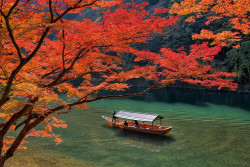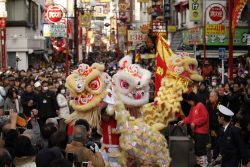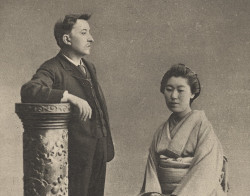
January 13, 2005
FOREST IN THE CLOUDS
Rainswept trails and lush beauty await in Costa Rica's Monteverde Nature Preserve
By Metropolis
Originally published on metropolis.co.jp on January 2005

Photos by Simon Rowe
DAYBREAK COMES WITH THICK MIST and drizzle in Santa Elena. Ask the locals and they’ll shrug and say the rain is a gift from the gods.
In this mountain hamlet in Costa Rica, bad weather means good business: Rainproof ponchos are in big demand among the ill-prepared tourists who pass through town on their way to the rainforest.
The cause of this big wet is the Monteverde Cloud Forest Preserve, which looms above Santa Elena like a damp green carpet spanning 6,500 hectares. Set up by American Quakers in the mid-’60s, the rainforest sanctuary is today privately owned and managed by the Costa Rican Tropical Science Centre (TSC).
From the port of Puntarenas on the Pacific coast, it takes a bone-shaking four hours in a decommissioned, US-registered school bus along roads little more than widened goat tracks to reach Monteverde.
Once in Santa Elena, the extent of its frequent deluges becomes apparent. Thick, soupy mud fills the main street and finds its way into everything, even the coffee. While keeping the mud off your boots is hard, finding a local guide to take you into the rainforest is not.
In the cool early-morning mist, we saddle up our quarter horses for a six-hour trek into the sanctuary. We hope to encounter one of Costa Rica’s most rare and elusive birds, the resplendent quetzal. The Indians of the Caribbean lowlands once used its dazzling green-and-crimson plumage in their royal costumes.
For Raphael Cortez, or “Raffa” as he prefers to be called, guiding travelers into the Monteverde preserve is now a full-time job, and for independent trekkers he provides a welcome alternative to the neatly packaged tours dished out to tourists down in the bustling capital.

But even Raffa admits that the preserve’s fragile environment is in danger of being loved to death by the increasing numbers of visiting conservationists and adventurers. As a protective measure, the TSC now restricts park entry to 100 people a day while it negotiates the purchase of more forest from the government. A rotation program is also being put in place to ensure regrowth of the well-trodden trails.
Despite its difficulties, the center is proving that Costa Rica’s rainforests can be preserved—and yield higher economic returns through ecotourism than if cut down for timber and low-yield pasture.
In a rowdy Santa Elena bar the night before our excursion, Raffa agreed to guide us to the edge of the rainforest on horseback. From there it would be a 2km hike to a point high in the jungle where he sighted a pair of quetzals that week.
But heavy overnight rain has turned the steep mountain tracks into quagmires. The horses slip frequently in the mud, and fording the mountain streams becomes risky. Crossing open farmland, we encounter wind gusts so fierce that several horses slow to a complete standstill. With the effects of two hours of riding painfully impressing on my rear, I’m beginning to wonder if I will ever walk again—let alone hack my way through the jungle to sight the quetzal.
Roughly half of the 2 million known species of plants on Earth are found in this kind of rainforest; there are 2,500 species of plants in Monteverde alone. All around us, vines as thick as a man’s wrist tangle earthward from towering silk-cotton trees.
Bromeliads cling to their massive trunks, competing for what little light filters through the canopy. Iridescent hummingbirds dart through the undergrowth, sucking nectar from fiery red and yellow heliconia flowers and bringing yelps of delight from the biologists.
Suddenly, Raffa motions us to keep very still and quiet. We stand motionless, and a faint sound like the pitched notes of a flute comes from deep in the hollow. It is impossible to see more than a few meters in the misty gloom, but Raffa assures us it is the song of the quetzal.
Then rain begins to fall, a fine patter at first rising to a thunderous roar, drowning out all other noise and any chance we may have of locating our quarry. The quetzal has taken flight and vanished into the mist.
Raffa, however, is not about to let a little rain dampen our spirits. With a swipe of his machete, he slashes two thick vines, grabs hold of them and swings out into the forest like a madman.
For the next half-hour we swing like Tarzans through the jungle, screeching and yelping, slipping and sliding in the mud. The quetzal may have eluded us, but here in the primeval rainforest, our animal instincts have not.
The most direct routes from Japan to Costa Rica go via Los Angeles, Houston or Miami. United and American Airlines serve the capital, San Jose. The May-November rainy season is less crowded than other times: early or late in the season is ideal. The Monteverde Cloud Forest Preserve is reachable by public bus from San Jose, but for peace of mind, choose a tour operator in San Jose. The Cloud Forest Lodge (tel: 506-256-0096, US$40–$60 per night) is set in secluded primary rainforest; rooms have a private bathroom and rainforest views, and they offer horse-riding tours. The Albergue Reserva Biológica de Monteverde (tel: 506-645-5122, $10 per person per night) is located inside the preserve and is very popular with scientists and students. Reservations necessary. Guided walks in the Monteverde Cloud Forest Preserve (8am, $15; 7:30pm, $13) take four hours. Call the park office to reserve a place (506-645-5112). Official site of the Costa Rica Tourism Board: www.visitcostarica.com or see www.tourism-costarica.com.
[geo_mashup_map]







